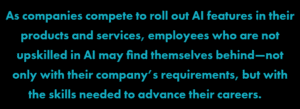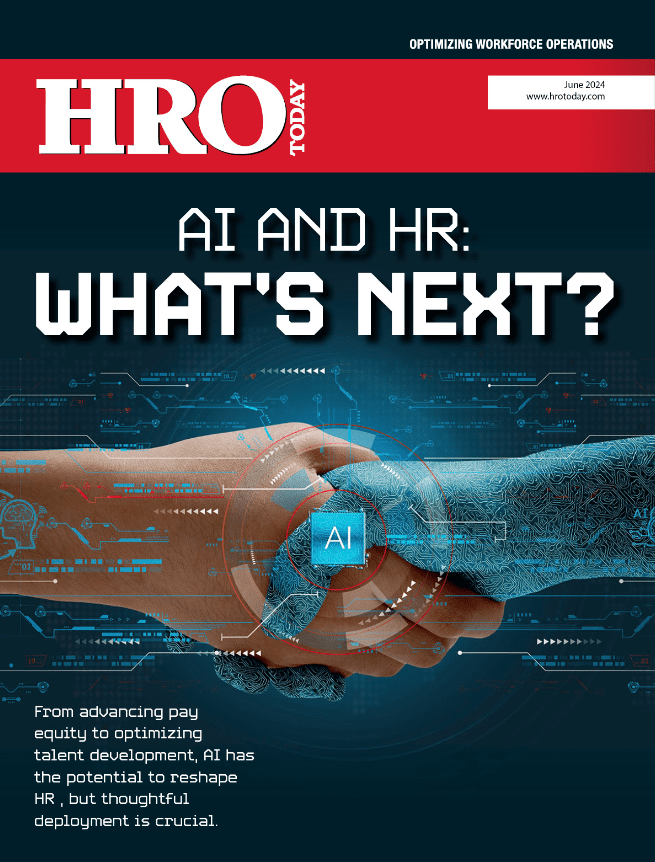As the shelf-life for many skills is shortened, HR leaders must adapt and invest in employee training and development.
By Maggie Mancini
The workforce landscape is rapidly changing. Skills previously viewed as “future-proof” are now impacted by artificial intelligence, and employees and employers who aren’t committed to learning and developing new competencies may struggle to adapt. In fact, the World Economic Forum estimates that 44% of workers’ skills will be disrupted in the next five years.
In response, HR leaders are grappling with how to design their L&D programs to build resilient organizations and keep employees motivated. Companies are investing in upskilling programs to improve the employee experience, providing them with the skills needed to stay agile.
The Perks of Employee Development
HRO Today’s 2023-2024 Top Annual Concerns of CHROs report finds that 70% of employees would leave their job for one that invests in their development, while 86% would stay if their company began investing in training. Whether new to the job market or well-versed in their industries, employees expect organizations to offer learning opportunities throughout their tenure, says Rasmus Arousell, people director and employee training expert at Attensi.
“Learning is seen as an asset, along with salary and benefits, whereas previously it was mainly company-driven and focused on being compliant or closing performance gaps,” Arousell explains. “The experience now is more of an expectation from the candidate market and existing employees that they want to work for a company that builds their career. If a company fails to do so, they will struggle with retaining high achievers and attracting top talent to their organization.”
Upskilling is essential to bring into any organization and has the potential to boost retention through engagement and personal growth, says Lori Cummings, senior vice president of people and culture at Skillable. Research from Skillable finds that 37% of tech workers struggle with a lack of training tied to their role, indicating the need for a data-driven approach to development.
“Supporting access to upskilling demonstrates their company commitment to investing in their growth, which is a differentiator amongst forward-thinking organizations aiming to create an engaged ownership mindset throughout their teams,” Cummings says.
Betty Thompson, chief people officer at Booz Allen Hamilton, says that empowering employees to grow their technological expertise is the best investment any company can make.
Thompson has led the development of Booz Allen’s “Tech Excellence” initiative, a cohort-based learning program that provides upskilling and reskilling opportunities to candidates, new hires, and existing employees in critical skill areas like cybersecurity, data science, modern software development, and cloud engineering.
“Offering upskilling and reskilling programs to all employees not only allows Booz Allen to build the best technical talent, but also its resilience,” Thompson says. “It equips employees with the necessary skills to thrive in the workforce of the future. As emerging technologies continue to develop at a rapid pace, it’s critical that organizations can ensure their workforce is ready to meaningfully engage with technology to drive results.”
Booz Allen’s upskilling initiative has boosted engagement and retention since the program’s inception in 2019. The company received positive employee feedback regarding its career development and tuition reimbursement programs, and its internal AI training offerings have seen a 337% increase in registration over the last year.
Upskilling For the AI Revolution
Artificial intelligence has already had a massive influence on HR, with organizations finding ways to leverage the technology to best suit their business needs. While there are concerns that jobs will be displaced by automation, there are plenty of ways that responsible AI deployment can benefit workers and employers alike.
Cummings says that companies are still responding to the fallout from the chaos of last year’s AI revolution. As companies compete to roll out AI features in their products and services, employees who are not upskilled in AI may find themselves behind—not only with their company’s requirements, but with the skills needed to advance their careers.
“Investment in upskilling employees is not just a retention tool, but a tactic in longer-term talent planning and ensuring depth of talent across an organization,” Cummings says. “Exposing new employees to new technologies through a platform that allows them to establish mastery quickly eliminates the costs behind time to productivity, regardless of learning style.”
When employees are confident in their ability to meet job expectations and managers are confident that team members are fully trained through an upskilling platform, they can set themselves apart from competitors, Cummings says.
This is important as data indicates that AI skills are gaining more attention than non-AI industry experience. By promoting upskilling initiatives to job candidates and existing employees alike, HR leaders are letting talent know that they can be upskilled and improve their qualifications in the job market, Cummings says.
Arousell says that the most impactful training programs focus on:
- making failure a natural part of training;
- incorporating high levels of repetition on topics; and
- providing a high degree of realism and connection to real-life scenarios.
Attensi’s approach to AI training is an example of these concepts at work. The organization leverages AI as an “in-the-pocket” coach for employees or leaders. Individuals can prompt AI within a virtual learning setting to design a training activity for themselves. For example, a leader heading into a difficult conversation with an employee can use AI to simulate the conversation beforehand, making sure they are prepared and feel secure.
“In addition to integrating the power of AI into existing high-impact digital training methodologies, AI has the potential to be integrated even closer to the day-to-day upskilling for employees,” Arousell says. “We know that most learning in an employee’s life cycle comes from on-the-job training, and with the use of AI in daily work, we can blur the lines between what is perceived as a productivity tool versus a training tool for employees on an individual level.”
Bridging the Skills Gap
Internal hiring is an important vehicle for closing skills gaps in an organization, according to the HRO Today report. Others include a strong educational pipeline (27%) and hiring from outside the industry (10%). To bridge these gaps, HR leaders should make upskilling curriculum available from day one so workers can feel “confident, competent, and capable,” Cummings says.
“Giving employees easy internal access to the technologies and hands-on training they need to succeed is considered due diligence on the part of any responsible organization concerned about consistent viability and strong organizational continuity,” she adds. “Upskilling can be a significant long-term play in succession planning, talent development, and business contingency planning.”
Employees in today’s workforce can’t ignore the need to understand how to leverage a variety of technological skills. Arousell explains that, as more mundane and routine activities are handled by AI and technology, skill sets related to behaviors will be even more important, and training for those skills will need to be scaled.
Companies are more globalized than ever, thanks to the lingering effects of the pandemic. This means that traditional learning methodologies—like classroom training and role-play situations—are even more difficult to arrange. HR leaders need to look at qualitative training methods to eliminate skills gaps, Arousell says.
Though the shortened shelf-life of many hard skills has resulted in knowledge gaps, a report from McLean & Company finds that soft skills—including leadership, organization, and team-building—are also lacking in the workplace. The percentage of non-office workers who are proficient in core and leadership skills, such as the ability to navigate change, work collaboratively, and understand the financial implications of their work, is low. And despite being prioritized, leadership skills are lacking among office workers (32%).
“Employees expect their organization to deliver a great example at work,” Arousell says. “This also goes for the training and learning activities within the organization. The days of day-long classroom training or role-plays are passing by, and organizations need to look for more exciting and interactive ways of delivering learning.”
With interactive training, employees are more likely to engage with the training and understand that the company is investing in them. Connecting game-based mechanics to virtual learning can simulate the reality of the workplace. This way, employees improve the ways they handle their daily responsibilities, feeling empowered by training and viewing their organization as invested in career development, Arousell says.
The Skills-Centric Future of Work
Skill building programs are vital to organizational success for employers and employees alike.
For companies, skill gaps will occur quicker than before and must be addressed to stay ahead of the curve in terms of industry developments. For workers, a growth mindset is crucial for individuals to stay employable and grow in their careers. This means organizations must provide the support and time for skill building and personalized training opportunities to increase performance, Arousell says.
“Professional development and upskilling play a huge role in employee retention, so organizations that don’t offer growth opportunities will be at much higher risk of workforce turnover,” Thompson says. “In today’s tight talent market, employers should be doing their utmost to retain the skills and experience of their people. Providing talent with avenues to enhance their technical skills allows an organization to simultaneously strengthen their workforce while also equipping employees with the training and certifications they desire to further their careers.”


















